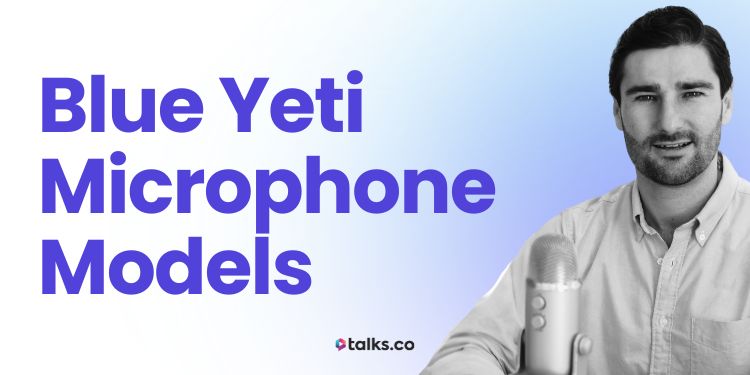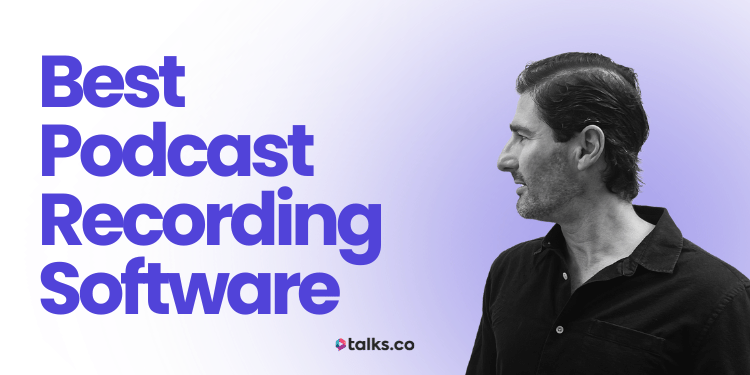You’ve got something to say. Maybe it’s your first podcast. Maybe you’re coaching, creating, recording and wondering if your mic can keep up.
The Blue Yeti microphone comes up a lot in recs, but is it actually the right fit for what you’re doing?
That’s what this guide is here to unpack.
I’ve used the Blue Yeti for solo shows, guest interviews, recording courses, even the occasional mid-day dad call. It’s held up through all of it.
This guide walks you through what it is, how it works, who it’s best for, and where it might fall short. By the end, you’ll know if it fits your setup or what to pick instead.
What Is a Blue Yeti Microphone?

The Blue Yeti is a USB condenser mic known for ease of use and versatile pickup patterns (cardioid, omnidirectional, stereo, and bidirectional mode). It connects directly to your computer with no mixer needed.
Great for podcasting, streaming, voiceovers, and calls. Beginner-friendly but capable of clear, detailed sound.
Who makes Blue Yeti microphones?
Blue Yeti is made by Logitech G, which absorbed Blue Microphones in 2018 and fully rebranded it by 2023. That means the same team building their professional streaming headsets and sensors is behind the Yeti line too.
Blue Yeti microphone best buy: What to choose and why
Best pick depends on your setup and budget:
- Best budget mic: Yeti Orb at $69.99
- Best compact option: Yeti Nano at $119.99
- Best for streamers: Yeti GX at $169.99
- Best all-rounder: Standard Yeti at $139.99
- Best podcast equipment bundle: Yeticaster at $199.99
- Best streaming pack: Yeti + C922 bundle at $229.99
- Best XLR upgrade: Yeti Studio at $379.99
How to Use the Blue Yeti Microphone
The Blue Yeti mic settings are plug-and-play. You can be up and recording in minutes.
- Plug mic into USB.
- Select “Yeti” in system sound input.
- Choose pickup pattern on back dial.
- Position upright, Blue logo facing you.
- Adjust gain and volume on mic.
- Start recording in your app.
(Optional: Add a pop filter for plosives.)
How to use Blue Yeti microphone on Mac
Plug it in using the USB cable, then:
- Go to System Settings > Sound > Input.
- Select “Yeti” as the input device.
- Open your recording software and select “Yeti” again.
- Position the mic 6-12 inches from your mouth for clean sound.
Headphones help if you want to monitor your audio quality live.
How to reset Blue Yeti microphone
There’s no physical reset button, but here’s the manual method:
- Unplug, wait 30 seconds, replug.
- Try different USB ports or devices if needed.
- Test recording with Voice Memos (Mac) or Voice Recorder (Windows).
- Check input levels, pickup pattern, gain, and mic position to fix issues.
How to test Blue Yeti microphone
To test before recording:
- On Mac: Open QuickTime > New Audio Recording or Voice Memos
- On Windows: Use Voice Recorder or your preferred DAW
Watch for input levels and listen for clarity. If it sounds off, check:
- Pickup pattern
- Gain setting
- Mic position
Those three fix most issues.
Does Blue Yeti mic have software?
You don’t need software to use it, but Logitech G offers Blue VO!CE, which adds EQ, presets, filters, and real-time voice tweaks.
It’s optional, but helpful if you want cleaner sound without using a DAW or full editing software.
Blue Yeti Microphone Types and Specs
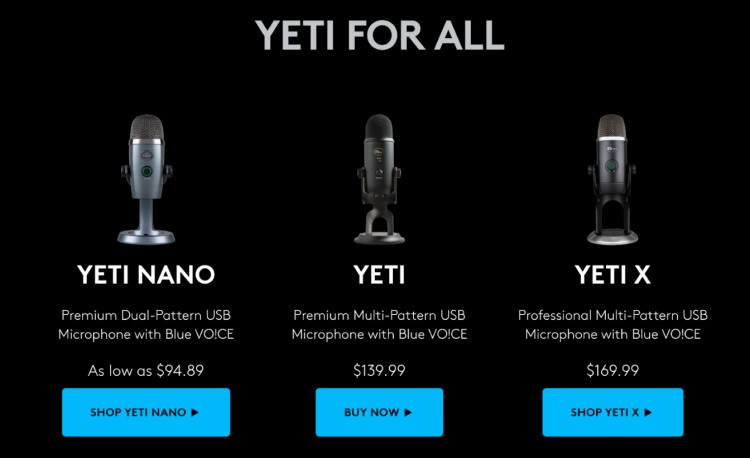
Not all Blue Yetis are the same:
- Yeti: USB-A, 4 patterns, 16-bit/48kHz, headphone jack, no software
- Yeti Nano: USB-A, cardioid and omni, 24-bit/48kHz, headphone jack, compact, no software
- Yeti X: USB-C, 4 patterns, 24-bit/48kHz, headphone jack, Blue VO!CE, LED meter
- Yeti Pro: USB-A + XLR, 4 patterns, 24-bit/192kHz (USB), headphone jack, no software
Blue Yeti microphone type
The type of Blue Yeti you go for affects everything from connection and compatibility to sound quality and control options.
Blue Yeti microphone USB
The Yeti, Nano, and Yeti X all use USB (A or C). Plug-and-play on Mac or PC. No need for an interface or mixer.
Blue Yeti microphone XLR
Only the Yeti Pro has XLR. Great if you want full control and already use an interface. Still works via USB too.
Blue Yeti microphone condenser
Every Blue Yeti is a condenser mic; sensitive, detailed, and best used in quiet setups. Perfect for podcasting, streaming, or voiceover.
Blue Yeti microphone specs
Here’s what makes each mic sound and feel different to use.
- Bit depth/sample rate: Nano and X offer 24-bit audio. The original Yeti is 16-bit. The Pro goes up to 192kHz via USB.
- Polar patterns: Yeti, X, and Pro have four. Nano only has cardioid and omni.
- Headphone jack: All have one for live monitoring.
- On-mic controls: Yeti and X have dials for gain, mute, and volume. X also adds an LED meter.
- Software support: Only Yeti X works with Blue VO!CE for built-in EQ, filters, and compression.
Blue Yeti Microphone Accessories
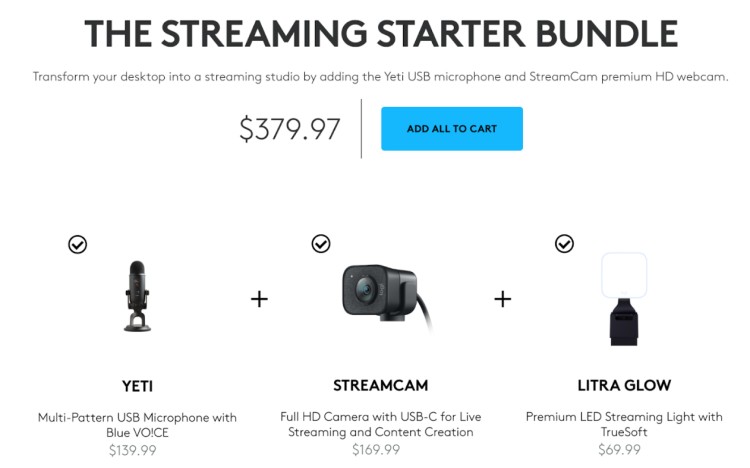
If you want better sound, less desk clutter, and a more pro-looking setup, the right accessories help. Start with a boom arm or grab a bundle that includes everything in one go.
Blue Yeti microphone boom arm
The Logitech COMPASS boom arm is designed for Yeti mics. Built-in cable management. Stays where you put it. No squeaks, no sagging mid-recording. Ideal Blue Yeti mic boom arm if you’re podcasting, gaming, or on Zoom all day.
Other boom arms can work too, but check weight support and mount size before you buy. The Yeti is heavier than most USB microphones.
Blue Yeti microphone bundle
Save cash and get everything in one go:
- Yeticaster: Yeti mic + COMPASS boom arm + Radius III shock mount. Solid choice for podcasts and VO.
- Yeticaster GX: Same setup with the Yeti GX (dynamic mic + RGB). More gamer-friendly.
- Yeti + C922: Yeti USB mic + 1080p webcam. Built for streaming or Zoom.
Some bundles include pop filters, cables, or Streamlabs themes depending on where you buy.
Blue Yeti Microphone Quality and Performance
You’ve seen the Blue Yeti everywhere but does it actually sound good? Here’s what to expect in terms of sound, build, and longevity.
Are Blue Yeti microphones good?
For a USB mic? Yes. The Blue Yeti delivers clear, full audio that’s great for podcasting, streaming, Zoom, and YouTube.
It’s a major upgrade from your laptop mic or cheap USB options especially if you speak close and use the right pickup pattern.
Is Blue Yeti the best microphone?
Depends on your setup:
- For beginners: Excellent pick. Simple, affordable, solid sound.
- For professional studios: XLR mics will give you more control and clarity.
It’s not high-end studio gear, but the Blue Yeti mic is worth it because it consistently outperforms most USB mics at its price point.
Blue Yeti microphone quality

You get:
- Crisp mids, decent bass, and solid vocal presence (especially in cardioid mode)
- Some background pickup in noisy spaces (it’s a condenser thing)
- Sturdy metal body and responsive gain and mute button
It’s not built to be dropped, but it is built to last.
How long do Blue Yeti mics last?
With normal use, easily 5+ years. Some users go even longer. Just avoid moisture, dust, or dropping it. It’s a solid piece of gear, not something you’ll need to replace often.
I’ve had mine since 2015. That alone should tell you about its ability to make it through the years.
How much does a Blue Yeti mic weigh?
The mic itself weighs about 1.2 lbs (0.55 kg). With the Blue Yeti mic stand, it’s 2.2 lbs (1 kg) total.
It’s heavier than most USB mics, which is why knowing which podcast mic boom arms are the best matters if you’re not keeping it on the desk.
Blue Yeti Microphone Use Cases
Blue Yetis are popular for a reason. They work well in the real world. I’ve used mine for podcast interviews, course recordings, client calls, even random “hey, are you working?” check-ins from my dad.
If you’re wondering if it’s the right mic for what you do, here’s where it actually holds up.
Blue Yeti microphone for podcasting
Launching a podcast? The Yeti makes it easy to sound great right out of the box:
- Clean, natural voice pickup
- Multiple pickup patterns (solo or guest)
- USB plug-and-play, no extras needed
Pick: The standard Blue Yeti is one of the best podcast microphones because it covers everything most podcasters need.
Blue Yeti microphone for gaming
The Yeti helps your voice stay front and center without distracting noise.
- Clear voice with solid background rejection (when used right)
- On-mic mute and gain controls
- Headphone jack for no-lag monitoring
Pick: The Yeti X gives gamers more control, including EQ presets via software.
Blue Yeti microphone for streaming
Live streamers need clean, consistent audio and the Yeti delivers.
- Switchable pickup modes for solo or multi-person setups
- Built-in monitoring (no lag)
- Works with OBS, Streamlabs, and other popular tools
Pick: The standard Yeti or Yeti Nano are both solid for most streaming setups.
Can I use Blue Yeti microphone with iPhone?
You can. Just know it takes a few extras:
- Lightning to USB 3 adapter (with power passthrough)
- Powered USB hub
- A compatible recording app (Voice Memos, GarageBand, Zoom)
How to connect Blue Yeti microphone to iPhone
You’ll need to:
- Plug the Yeti into the powered hub.
- Plug the hub into the adapter.
- Connect the adapter to your iPhone.
Most apps will detect the mic automatically. You’ll get studio-level sound, but expect faster battery drain.
Blue Yeti microphone for iPhone pros and cons
Thinking mobile? Here’s what works and what doesn’t:
Pros
- Better sound than any built-in iPhone mic
- Works with most adapters and iOS apps
- Portable for remote recording
Cons
- Needs a powered hub and adapter
- Bulky for a mobile setup
- Limited control from iPhone apps
Blue Yeti Microphone Comparisons and Alternatives
Not sure if the Blue Yeti fits your setup? Here’s how it compares to other mics at similar price points and one solid alternative if you want something different.
Blue Yeti microphone vs HyperX QuadCast
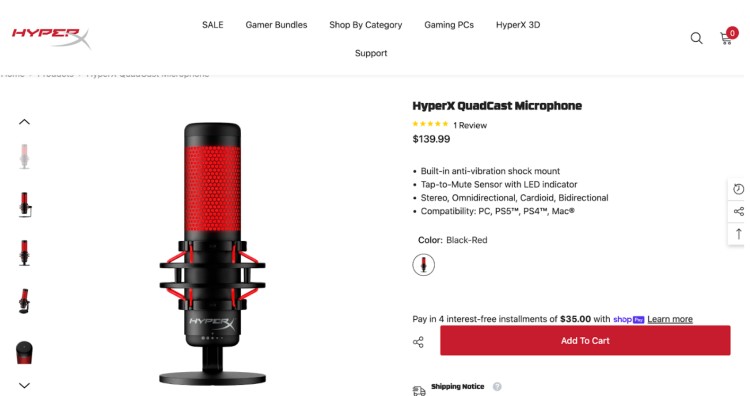
HyperX QuadCast is built for streamers with features like tap-to-mute and an anti-vibration shock mount.
- Yeti: Heavier build, natural sound, versatile pickup patterns.
- QuadCast: Gamer-focused design, LED mute indicator, built-in pop filter.
Choose Yeti for clear podcast or voiceover work. QuadCast is great if you want easy controls for live streaming.
Blue Snowball mic vs Blue Yeti
Snowball is simpler but it’s one of the best budget microphones with a single cardioid pattern and no onboard controls.
- Snowball: Compact, plug-and-play, affordable.
- Yeti: More versatile, four pickup patterns, gain and mute controls.
Pick Snowball if you want a quick setup with decent sound. Go Yeti for more control and better quality.
Blue Yeti microphone vs gaming microphone
For gaming, the Razer Seiren X is a strong contender. It’s compact, with a built-in shock mount and focused cardioid pickup to reduce background noise.
- Razer Seiren X: Made for gamers, minimal desk footprint, easy to set up.
- Yeti: Bigger, versatile patterns, more suited for multi-use content.
Use Seiren X if your main focus is gaming. Yeti works better for podcasting and recording.
Blue Yeti microphone alternative
The Elgato Wave:3 ($149.99) is a strong alternative to the Blue Yeti, offering:
- Clear, detailed sound with a condenser capsule
- Compact, modern design that fits small setups
- Software control for easy volume, EQ, and noise gate adjustments
- Built-in clip guard to prevent distortion on loud sounds
- USB plug-and-play with Mac and PC compatibility
Blue Yeti mic under $5,000
All Blue Yeti models are well below $5,000, typically priced around $100 to $170. If you find listings much higher, avoid those deals.
Blue Yeti Microphone Purchase and Pricing

Whether you’re starting your podcast recording from scratch or upgrading your setup, here’s what you need to know before you use the Yeti models, current prices, and where to get the best deal.
How much is the Blue Yeti microphone?
Here’s the current pricing based on Logitech’s latest lineup:
- Yeti Orb: $69.99
- Yeti Nano: $119.99
- Yeti GX: $169.99
- Standard Yeti: $139.99
- Aurora Collection: $139.99
- Yeti Studio: $379.99
- Yeti + C922 pack: $229.99
- Game Streaming Kit: $149.99
- Yeticaster Bundle: $199.99
Logitech also runs occasional discounts, especially if you bundle a mic with a light or webcam.
Doing extra prep? Read this to know how much podcast equipment costs.
Where to buy Blue Yeti microphone?
Here are the most reliable places to buy:
- LogitechG.com: Full range of models and exclusive bundles with support.
- Amazon: Competitive pricing on most models, especially the standard Yeti and Nano.
- Best Buy, Staples, Walmart: Most models available both online and in store.
- Sweetwater, B&H: Best for musicians or podcasters who want XLR gear alongside their Yeti.
- Used or refurbished markets: Sometimes cheaper, but you may miss out on warranty coverage.
Sound Good? Now Let’s Make Your Episodes Better
The Blue Yeti microphone is popular for a reason: it’s simple, sounds great, and gets you recording fast. But as a podcast host, the mic is only part of the setup.
What really makes your show stand out? The guests.
Skip the email tennis and cold pitches.
Create your free Talks creator profile and get matched with guests who bring real stories and fresh takes without all that back-and-forth.
Want your next 3 episodes to feature guests who get people talking?
Create your Talks profile for free and start filling your calendar with episodes that hit.
